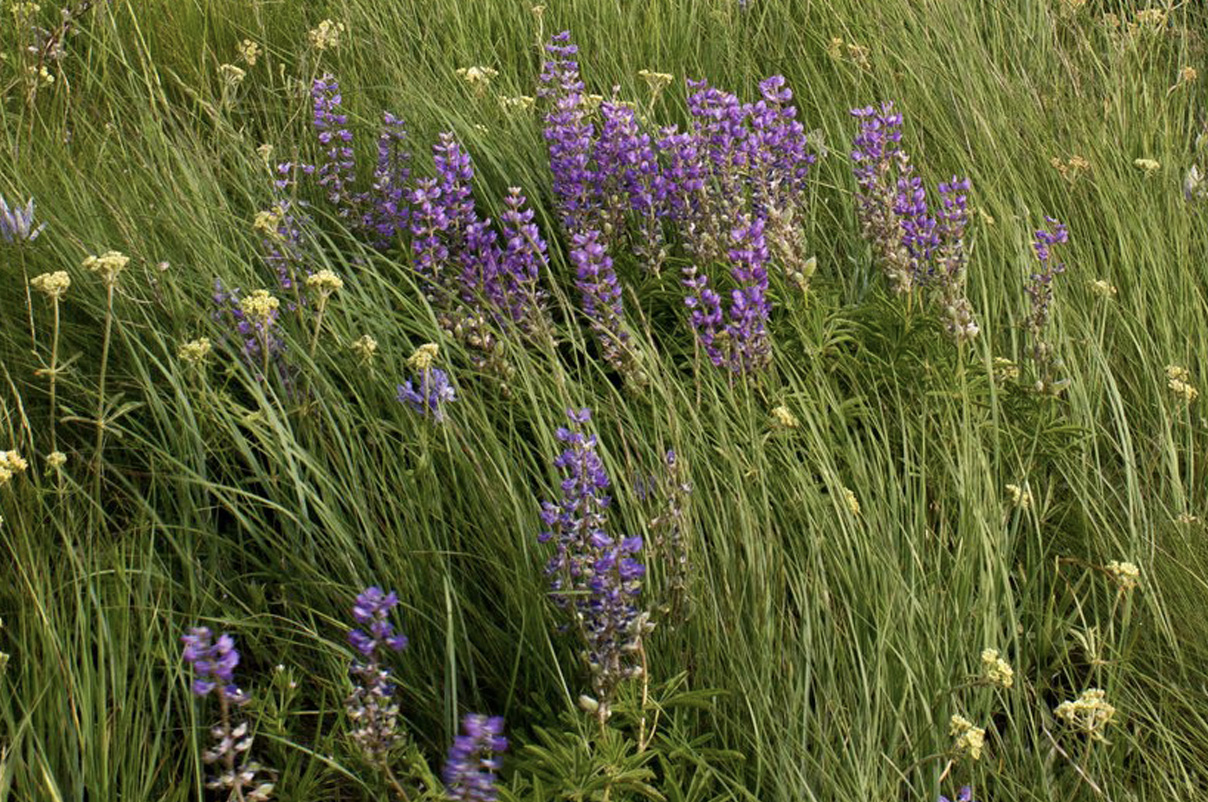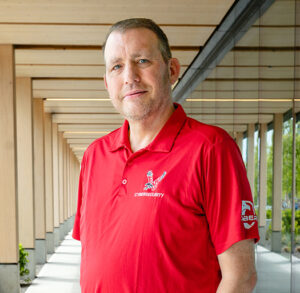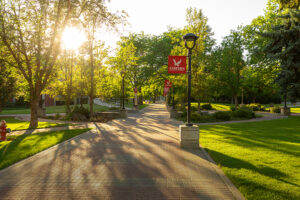Beauty Wild and Untrammeled

Can Eastern Restore a Long-Lost Patch of Prairie?
By Charles E. Reineke
In the days before the land was plotted, plowed and paved, the patch of Palouse prairie that EWU calls home was part of a wild, magnificent landscape; a terrestrial ocean of sun-kissed rolling hills carpeted by a vast, kaleidoscopic medley of native flora.
Throughout the year, grasses such as bluebunch wheatgrass (Pseudoroegneria spicata), Idaho fescue (Festuca idahoensis), and Basin wildrye (Leymus cinereus) created a luxuriant carpet of green and gold. Each spring, displays of multi-hued forbs — the herbaceous flowering plants that were especially prevalent in the pre-industrial Palouse — turned the hills into great, Crayola-colored super blooms. In late summer and fall, the land’s Native people sustainably harvested the berries and edible-root plants that also thrived in the rich, deep soil.
“Its beauty was wild and untrammeled and the undulating hills were covered with luxuriant grasses,” wrote a homesteader who moved to the Palouse about the same time that the Benjamin P. Cheney Academy opened its doors to students. Such appreciation, however, did not deter similar Euro-American arrivals from aggressively altering the landscape. First by grazing cattle, then by intensively cultivating wheat and barley, the new arrivals — often unwittingly — ensured that the Palouse’s finely balanced ancient ecosystem would be rapidly and perhaps inalterably transformed.
Today almost nothing of the original Palouse prairie remains. If in only a small way, Eastern Washington University hopes to change that.
Earlier this year, EWU administrators announced a plan to restore a 120-acre parcel of university-owned farmland to its native habitat, thus creating a “living laboratory” of restored Palouse prairie proximate to the Cheney campus. This Prairie Restoration Project, to be developed in cooperation with representatives from area Native communities, is meant to advance student research and learning opportunities, to create a model for boosting regional biodiversity and to provide an education and recreational space connecting visitors to a long-lost landscape.

“This project is the perfect example of the kind of work that we do at this university,” EWU President Mary Cullinan told a crowd gathered at the project site in May. “We do research that is applied. We work to solve problems.”
Noting the partnership with area tribes, Cullinan said “we respect the fact that it was tribal land that our beautiful university is on.”
Carol Evans, Spokane Tribe chairwoman, also emphasized the importance of connecting with the land and learning from it. “We are going to do something wonderful here together,” she said.
As envisioned by Erik Budsberg, project leader and sustainability coordinator with EWU’s Facilities and Planning Office, restoring Eastern’s prairie will be a true multi-disciplinary affair. “A big part of the project is to make it really inclusive,” Budsberg says. “We want to use it to sort of de-silo things, to truly create a lot of interdisciplinary relationships and opportunities across campus.”
The restoration effort, now in its “pilot phase,” has already attracted broad interest. Geography students, for example, have been using GPS-mapping techniques to provide guidance on potential land-use decisions.
Biology students and faculty members have taken advantage of grant funding from the Environmental Protection Agency to share prairie-related conservation knowledge with local school children and the wider community. And during a recent visit, a graduate student in archaeology was on site digging for artifacts related to previous habitations.
In a more general way, the site will serve as a test case for how competing institutional interests can co-exist. Can, for example, research, teaching and recreation really thrive in such a space?
Budsberg believes they can. As the project moves through its three-stage development plan, he says, facilities planners, research faculty and EWU students will corroborate to develop management plans, cost estimates and the identification of potential external partners that can help advance the project’s three-fold goal.
When the actual physical restoration work begins, at a date yet to be determined, task one will be preparing the ground for native grass and forb plantings, while, at the same time, constructing a trail system. Such trails, Budsberg explains, are more than just a recreational amenity; they are crucial to making the research, teaching and recreation piece come together. Not only will trails provide EWU students and campus visitors with an interpretative education experience, they will also serve to keep enthusiastic guests from inadvertently trampling on research plots and fragile soils.
Even the most generous estimates of the extent of “remnant” patches puts the total at less than one percent. Some ecologists believe there may be even less.
During the project’s final phase, planners envision using educational signage, strategically placed benches, outdoor classrooms, and even a mountain bike “skills center” to attract and instruct visitors.
But first things first. In the current pilot phase of the project, research will predominate. The reason is straightforward, says project advisor Kurt Merg: Surprisingly few university experts have spent much time studying the Palouse.
Merg, a Wisconsin farm kid who grew up to become a research scientist and vegetation ecologist with Washington’s Department of Fish and Wildlife, says while other forms of prairie-related research have attracted intense research interest around the nation, “there are no academic researchers that are taking on Palouse prairie per se.”
What interest there has been, he adds, has come mostly from what he calls “practitioners;” professionals working with the Department of Fish and Wildlife and “folks in the seed business, people working on private restoration projects, and some non-governmental organizations.”
This scarcity of academic inquiry gives an added urgency to Eastern’s restoration project, especially given how little remains of the original Palouse prairie. Even the most generous estimates of the extent of “remnant” patches puts the total at less than one percent. Some ecologists believe there may be even less.
More daunting still is the lack of success with previous restoration attempts. “Nobody has succeeded in replicating the diversity represented in the best of the few, extant prairie remnants,” Merg says. “That said, it took approximately one hundred and fifty years to destroy most of the Palouse prairie. Most of our attempts to restore it are fewer than 20 years old, and most are still slowly recruiting new species. Maybe the ‘problem’ is that we haven’t been trying for long enough.”
This glass-half-full attitude is typical of those involved in Eastern’s prairie restoration effort, particularly among the graduate student researchers who will be doing the scientific leg work necessary to make it happen.
Among them is Erik Peterson, 32, an EWU graduate student studying soil biology. A native of the Tri-Cities area, Peterson did his undergraduate work at Washington State University. At Eastern’s research greenhouse, a facility located atop a slab of decidedly un-prairie-like asphalt, Peterson is working with his advisor, Rebecca L. Brown, professor and chair of the biology department, to get a handle on how microorganisms native to Palouse soils have fared over time.
Previous research by Brown and others has shown that agriculture in the Palouse hasn’t just changed the flora and fauna that we see, it has also dramatically altered the ground below. To put it most simply, the unique and diverse soil communities that sustained the original prairie have, thanks to decades of grazing and tillage, been replaced by a more limited cast of bacterial characters. The change has had a profound effect on what plants will thrive there.
Peterson says making the prairie bloom again will mean understanding what came before, and then recreating it.
“Just like in our gut microbiomes, there are symbionts and pathogens in the soil,” says Peterson. “One of soils’ most important symbiotic interactions with plants involves a group called the arbuscular mycorrhiza fungi, or AMF. It is thought to be one of the oldest biological associations on the planet — that the AMF communities allowed plants to shift from aquatic to terrestrial communities some 450 million or so years ago.”
In rows of six-inch planters on large plastic trays, Peterson has assembled a collection of soils from remnant Palouse prairie — those small, rare plots of land such as Whitman County’s Kamiak Butte park that have never been farmed — alongside soils of agricultural sites. He then introduces both native and non-native plants into these “pot cultures,” taking note of their growth and nutrient uptake.
Native plants, researchers like Peterson have learned, are especially dependent on Palouse-specific AMF communities, and vice versa. “AMF can’t survive without a plant host, and any kind of tilling destroys those communities,” he says.
Rebuilding AMF communities on Eastern’s restored prairie won’t be easy. It will essentially involve “inoculating” the modern, AMF-depleted soil with fungi harvested from native prairie. The hope is that such inoculations will be sufficient to boost native grasses and forbs while impeding the spread of non-native, invasive plant species. Peterson thinks he and his colleagues can pull it off. “We’re confident that we can grow, harvest and put direct transplants into the site,” Peterson says.
‘One of soils’ most important symbiotic interactions with plants involves a group called the arbuscular mycorrhiza fungi, or AMF. It is thought to be one of the oldest biological associations on the planet.’
Fellow EWU graduate student Sarah Hill, an engaging, voluble, plant biology specialist from Ridgefield, a small town in southwest Washington, shares this conviction. Hill, 32, earned a bachelor’s degree in life science from the University of Portland, then worked at the Ridgefield National Wildlife Refuge as a program director at the refuge’s Cathlapotle Plankhouse.
Her studies at Eastern span both environmental investigation and community outreach. An example of the latter is an ongoing relationship she and the university have cultivated with the Salish School of Spokane, a private K-12 school dedicated to preserving the culture and language of regional Native American tribes. “They have been learning about different prairie communities, and helping us propagate some of the plants that are going to be used in the project,” Hill says. “Definitely engaging with our Native community, both on campus and off, is an important goal of the project.”
On the science side, Hill and her advisor Robin O’Quinn, an associate professor of biology at EWU, are working with forbs, those flowering plants that once defined the prairie’s identity — at least in the minds of early European visitors.
Kurt Merg fills in the role forbs played in the original prairie, and possibly why they were so quick to disappear, along with fauna that depended on them, following the advent of modern agriculture.
“Forbs contribute the greatest proportion of species diversity that we see in the best Palouse prairie remnants. This diversity likely contributed to overall ecosystem function in such myriad fashion that we can’t decipher, at this point, the full consequence of their loss,” Merg says. “One example often cited among our wildlife biologists is that, unlike grass, forbs do not contain very much silica, a physical defense in grasses against grazing. Forbs are essential to supporting herbivorous insects, which themselves are essential to young birds — like pheasants or our native sharptail grouse. Imagine now that the land, largely devoid of forbs, is unable to produce the seasonal abundance of insects upon which an entire food chain once depended. This is the kind of role we suspect that forbs once played here.”
Reestablishing forbs is notoriously difficult. So far, no one is sure exactly why. It’s a question that both intrigues and motivates Hill. “How do we get more than, say, four perennial forbs species in prairie sites; that’s like the question in Palouse restoration,” she says. The scope of her efforts won’t be sufficient to solve the riddle, she admits. But she’s doing her part.
Hill is looking at how soil moisture affects growth rates of Arrowleaf balsamroot (Balsamorhiza sagittata), a flowering forb common in the Palouse, the channeled scablands to the east of the prairie and across Eastern Washington. For restoration, she says, it’s perfect. “It’s super drought tolerant once it’s established; it’s hardy, it’s beautiful, pollinators love it, deer like to eat it — all of that.”
Just as Peterson’s work revolves around soil health, Hill’s project also starts at ground level. One key to reestablishing Arrowleaf balsamroot, as with many other forbs, involves understanding the conditions that it needs to thrive. Standing in front of her own array of plant-filled plastic pots, Hill explains the challenges related to forb renewal.
“I was trying to establish if the timing of different levels of soil moisture would affect growth and root biomass,” she says. “So, I set up this multi-pot experiment. It was working out just fine and then…” here Hill pauses. “… we got fungus gnats.”
“Fungus gnats eat plant roots,” she says. “If I was just growing these to transplant that would be fine because a little bit of root damage might not be a big deal. But because my data are dependent on the weighing of root biomass at the end — and comparing biomass across these treatments — if the roots are damaged I won’t be able to obtain reliable data from the root weights.”
Such challenges will undoubtedly be common, and even a cursory visit to EWU’s restoration site provides a visitor with a sense of the enormity of the project. Still, says Budsberg, fungus-gnat-style setbacks notwithstanding, there’s every reason to be confident Eastern’s restored prairie will be a success.
‘Prairie cannot be replaced. Were we to allow the last remnant to be destroyed, we would lose forever the unique inheritance of millennia.’
With recently cut wheat stalks crunching underfoot — after more than 50 years of cultivation this year’s harvest will likely be the last — Budsberg gazes out over the sun-dappled hills to the Cheney campus spread out below.
“It’s interesting,” he says, “how easy it is, when you’re down there on campus, to forget that Eastern is part of this beautiful, unique Palouse environment. We obviously hope to do a lot with this project, but one key outcome for me is to help the university community develop a real sense of place, that we are all a part of this amazing Palouse setting.”
Standing next to him, Merg nods in agreement. Later he elaborates on why restoration professionals like him work so hard to help projects like Eastern’s succeed.
There are practical reasons: Recent research suggests that the monocultures of modern agriculture, while amazingly productive, are becoming problematic for soil health. In addition, deploying prairie strips among these intensely cultivated fields can reintroduce habitat for insect predators of pests, thus reducing the need for chemical pesticides. And cultivating hedgerows of wild, flowering plants can attract pollinators that can then help pollinate adjacent crop plants, too.
But the full value of prairie, Merg says, transcends economics.
“Prairie cannot be replaced. Were we to allow the last remnant to be destroyed, we would lose forever the unique inheritance of millennia. You can’t recover species that are wholly lost; you can’t reassemble communities when the members of those communities are extinct. Why exactly would we deliberately decline this inheritance?”
— To learn more about EWU’s Prairie Restoration Project, and what you can do to support it, visit ewu.edu/prairierestoration
Additional resources
Filed Under: Campus Featured Science
Tagged With: Fall/Winter 2019


